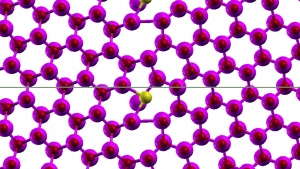Jun 2 2009
If solar cells were transparent they could be fitted to windows and building facades. Physical modeling helps in the development of suitable materials for transparent electronics and thus in creating the basis for transparent solar cells.
 Irregularity in an ordered crystal structure. © Fraunhofer IWM
Irregularity in an ordered crystal structure. © Fraunhofer IWM
Offering a view of the garden and an adjacent field, it looks like any other window. But this window offers an additional feature: it also produces electricity. The facades of the house, too, harness solar energy to supply the occupants with electrical power. This is what the domestic power supply of the future could look like. The surface area used to produce energy would increase greatly with transparent solar cells.
To translate the vision of see-through solar cells and transparent electronics into reality, two different transparent coatings would be required – one to conduct the electricity via electrons, the n-conductors, and one in which electron holes enable the electricity to flow, the p-conductors. To produce these coatings the engineers dope the base material with a few other atoms. Depending on which atoms they use, they obtain the differently conducting coatings. N-conducting transparent materials are state of the art, but the p-conductors are problematic. Their conductivity is too low and often their transparency is poor. Manufacturers need a transparent base material which is amenable to both n- and p-doping.
At present, indium tin oxide is mainly used for the n-conductors, but this is costly. Indium has become a rare commodity and its price has increased tenfold since 2002. The search for substitute materials is therefore in full swing. At the same time, various questions need to be answered, such as which materials would be best suitable, what they should be doped with to obtain good conductivity, and how good their transparency is. Research scientists at the Fraunhofer Institute for Mechanics of Materials IWM working in cooperation with other Fraunhofer colleagues have developed material physics models and methods which help in the search. “If transparent p-conductors with adequate conductivity could be produced, it would be possible to realize completely transparent electronics,” says Dr. Wolfgang Körner, research scientist at the IWM. Using electron microscope images, the researchers initially determine the grain boundaries which most frequently occur in the material – i.e. irregularities in the ordered crystal structure. These defect structures are modeled atom by atom. Special simulation methods calculate how the electrons are distributed in the structures and thus in the solid body. From the data the researchers extract how conductive and transparent the material is. “We have found, for example, that phosphorus is suitable for p-doping zinc oxide, but that nitrogen is more promising,” says Körner.